Many of my favorite stories in science fiction and fantasy deal with exploring an alien culture. I really like to see different species learning to communicate with each other, or an alien viewpoint on a more familiar human culture. It often requires the writer to step outside the box and create a point of view that takes into account different physical and mental abilities, a different environment, a different way of thinking.
I’ve always been drawn to these kinds of stories, especially the ones that are told through alien viewpoints, especially non-humanoid aliens. I’ve always liked getting into the point of view of characters that are different from me, and seeing the world through their eyes.
There are a number of SF/F books and stories that deal with these themes, but below are five(ish) older works that were big influences on me, and that explore alien-human communication from different angles.
Leviathan’s Deep by Jayge Carr (1979)
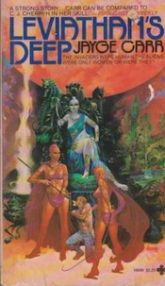 The alien Delyene in Leviathan’s Deep are in the process of being contacted/invaded by a human military star empire. The Delyene are matriarchal, have their own agendas, and they have secrets they know they can’t let the humans discover. The humans have some basic misconceptions about Delyene culture and biology; they want to control the Delyene but they don’t understand them. This is not a happy fun book, but it is a great story with an alien point of view, about alien contact going terribly wrong.
The alien Delyene in Leviathan’s Deep are in the process of being contacted/invaded by a human military star empire. The Delyene are matriarchal, have their own agendas, and they have secrets they know they can’t let the humans discover. The humans have some basic misconceptions about Delyene culture and biology; they want to control the Delyene but they don’t understand them. This is not a happy fun book, but it is a great story with an alien point of view, about alien contact going terribly wrong.
Survivor by Octavia Butler (1978)
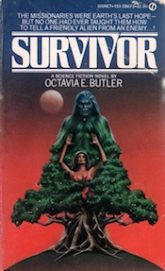 After fleeing earth to an alien planet, a human colony ends up caught in a war between two alien cultures, the Garkohn and the Tekkohn. The humans’ lack of understanding and misconceptions allows the Garkohn trap them and take complete control of the settlement without the humans realizing it. The main character, Alanna, is an outsider to the human group and the only one to realize what is really happening to them. Then Alanna is captured/rescued by the Tekkohn, and ends up gradually learning and joining their culture, though it isn’t an easy process. There are a lot of human-in-an-alien-culture stories, but Survivor was the first one I remember reading (I was fourteen and probably a bit young for it) and it made a huge impression on me.
After fleeing earth to an alien planet, a human colony ends up caught in a war between two alien cultures, the Garkohn and the Tekkohn. The humans’ lack of understanding and misconceptions allows the Garkohn trap them and take complete control of the settlement without the humans realizing it. The main character, Alanna, is an outsider to the human group and the only one to realize what is really happening to them. Then Alanna is captured/rescued by the Tekkohn, and ends up gradually learning and joining their culture, though it isn’t an easy process. There are a lot of human-in-an-alien-culture stories, but Survivor was the first one I remember reading (I was fourteen and probably a bit young for it) and it made a huge impression on me.
The Pride of Chanur by C.J. Cherryh (1981)
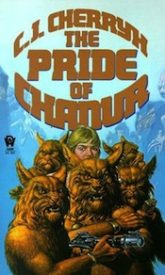 The hani are furred, catlike aliens, with an advanced star-faring civilization, interacting with other alien cultures in a trade organization called the Compact. While docked on a space station, the hani crew of the starship The Pride of Chanur find a strange creature escaping from their enemies the Kif. That creature is a human, an unknown species, and the Kif want him back. This is the first books of a series, and it’s a human-in-alien-culture story, but told from the hani’s point of view as they try to understand and communicate with a member of this strange new species. It’s a great example of an immersive alien viewpoint, as well as a fabulous adventure story.
The hani are furred, catlike aliens, with an advanced star-faring civilization, interacting with other alien cultures in a trade organization called the Compact. While docked on a space station, the hani crew of the starship The Pride of Chanur find a strange creature escaping from their enemies the Kif. That creature is a human, an unknown species, and the Kif want him back. This is the first books of a series, and it’s a human-in-alien-culture story, but told from the hani’s point of view as they try to understand and communicate with a member of this strange new species. It’s a great example of an immersive alien viewpoint, as well as a fabulous adventure story.
A Judgment of Dragons by Phyllis Gotlieb (1980)
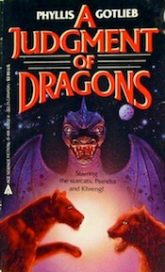 In the four novellas in this book, the aliens are large panther-like telepathic cats, who are trying to take their place in an intergalactic star empire. The stories are all from their point of view, and they end up solving unusual mysteries while coping with strange worlds and hostile alien entities. They often have to deal with equipment that isn’t designed for their bodies or eyes, and humans who want to see them as savage animals. These are great stories, and the alien viewpoint is fascinating and easy to sympathize with.
In the four novellas in this book, the aliens are large panther-like telepathic cats, who are trying to take their place in an intergalactic star empire. The stories are all from their point of view, and they end up solving unusual mysteries while coping with strange worlds and hostile alien entities. They often have to deal with equipment that isn’t designed for their bodies or eyes, and humans who want to see them as savage animals. These are great stories, and the alien viewpoint is fascinating and easy to sympathize with.
Uhura’s Song (1985) or Hellspark (1988) by Janet Kagan
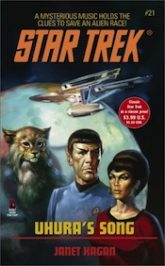 I’m cheating here because I couldn’t pick between these two books. The main character of Hellspark has to solve a murder mystery among a group of explorers from widely varied cultures who all communicate in different and often contradictory ways. She also needs to try to figure out a way to communicate with the Sprookjes, a newly discovered alien race, to save their planet from exploitation. It’s an alien contact story and it explores the differences and difficulties of communication among all the widely varied human cultures.
I’m cheating here because I couldn’t pick between these two books. The main character of Hellspark has to solve a murder mystery among a group of explorers from widely varied cultures who all communicate in different and often contradictory ways. She also needs to try to figure out a way to communicate with the Sprookjes, a newly discovered alien race, to save their planet from exploitation. It’s an alien contact story and it explores the differences and difficulties of communication among all the widely varied human cultures.
Uhura’s Song is a Star Trek novel where the Enterprise crew has to communicate with a civilization of cat-like aliens who have the cure to a terrible disease. The aliens would give them the cure, but its existence is hidden in a historical mystery that the crew can only unravel be understanding and learning the alien’s culture. It’s a great story about two cultures who basically want to cooperate with each other, trying to figure out how to do it. It shows how difficult alien contact can be even when both parties are trying their best to make things work.
Originally published in June 2015.
 Martha Wells is a science fiction and fantasy writer, whose first novel was published in 1993. Her most recent series are The Books of the Raksura for NightShade Books and The Murderbot Diaries for Tor.com. Artificial Condition, book two of The Murderbot Diaries, is available now. Besides many fantasy novels, she has also written short stories, media tie-ins for Star Wars and Stargate Atlantis, YA fantasies, and non-fiction.
Martha Wells is a science fiction and fantasy writer, whose first novel was published in 1993. Her most recent series are The Books of the Raksura for NightShade Books and The Murderbot Diaries for Tor.com. Artificial Condition, book two of The Murderbot Diaries, is available now. Besides many fantasy novels, she has also written short stories, media tie-ins for Star Wars and Stargate Atlantis, YA fantasies, and non-fiction.










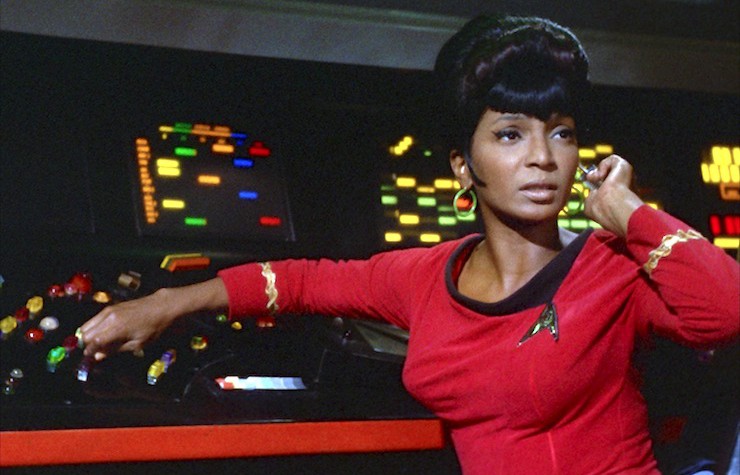
Zelazny’s story “A Rose for Ecclesiastes.”
Any of Cherryh’s Foreigner books about the atevi but especially the Defender/Explorer books.
Amy Thomson’s two tales of the Tendu, an amphibian species who communicate with color cells in their skin and the human biologist whose body is altered to permit her to use “color” speech, The Color of Distance and Through Alien Eyes, are great examples of non-verbal aspects to communication with non-humans.
Or not. China Miéville’s Embassytown shows how difficult and even dangerous it can be. Peter Watts’ brilliant Blindsight suggests that it can’t be done at all.
Kagan’s Hellspark is a favorite of mine. James White’s Sector General books are fantastic; I have no idea how I missed them when they were published. His treatment of women is somewhat dated, but the stories are great. Kaia Sønderby’s Xandri Corelel series follows a high functioning autistic woman’s career as an alien linguist, and I highly recommend it.
I’m just going to point out the non plus ultra of First Contact novels, The Mote in God’s Eye, right now to save someone else the trouble.
I was going to come in here and make sure Cherryh’s Foreigner books got a mention, and comment #1 beat me to it!
Though I do love the Chanur books too, the Foreigner books have a special place in my linguistics-loving heart.
Missed probably the best one: The Story of Your Life by Ted Chiang
Sue Burke’s Semiosis is in my opinion the very finest example of this genre.
I absolutely adore the Foreigner sequence, but really Cherryh vastly oversells the ‘alienness’ of the Atevi–it’s very much something which exists more in the narration than the action, if you take my meaning.
Though thinking about it, the ones in which they first meet the Kyo are rather more in this vein as RobM mentioned above.
I really liked Hellspark too.
There’s Naomi Mitchison’s Memoirs of a Spacewoman – the main character is a “communicator” with alien species.
Then there’s J.D. Sausage and the rest of the alien contact department in the Starfarers series. I thought J.D. would have been a really cool character if she were less diffident, and the character Stephen Thomas drove me just as batty as his unhyphenated first name did. The series was a really fascinating “near miss” for me – if some of the characters and plot points had been just slightly different, I would have loved it.
As it was, it was pretty entertaining reading what was almost a space opera, but without a bunch of space navies and photon cannons (there’s conflict, but it’s different to the usual).
“Sausage” = “Sauvage”
Thank you, auto-correct!
I’m with you on “Story of Your Life,” @OysterZed. My mind was never the same afterwards.
Adding some of these (and from the comments) to my tbr pile immediately! I also loved Embassytown by China Mieville, and The Sparrow and its follow up Children of God by Maria Doria Russell.
“Little Fuzzy” by Piper is a pretty good story along those lines, and a good mystery, courtroom drama, and action novel, too.
And Stanislaw Lem’s Solaris where communication between human and alien is impossible despite both trying desperately.
Anne McCaffrey’s “Doona” series is a wonderful example of this. In the first book, “Decision at Doona”, humans establish their first colony on another planet, and are dismayed to find intelligent beings living there despite surveys that said it was empty. But they have to wait for the next ship to arrive, and are unable to avoid making contact with the seemingly primitive feline-humanoid Hrrubans. When the main character’s family arrive on the next ship, including his completely out of control six-year-old son, they still can’t go back; and the son has a breakthrough in communication, aided by his friendship with a young Hrruban, and his insistence on wearing a rope tail to look like his friend! When the big brass show up, the entire population of Hrrubans is nowhere to be found – because they are actually a technically advanced species with teleportation technology, and this was just one of their colonies! Eventually the truth all comes out, and the youngster translates as they develop a treaty and an experimental shared colony.
“Crisis on Doona” is set 25 years later, and doesn’t have any communication challenges in the plot – just trying to figure out who is sabotaging the joint colony that has been working well for the people who live there, if not the politicians on their homeworlds.
“Treaty at Doona” is a wonderful culmination. An alien spaceship approaches Doona, and representatives of both species go out to meet it and make first contact. There is considerable confusion when they have to explain that they are from two different worlds – because their cooperation was so complete that the aliens mistook their physical differences as being two genders of a single species. Then, of course, politics take over again…
Cherryh in general is one of my favorite authors at being able to convey some real sense of “otherness” when it comes to, well, others. She’d be terrible at writing forehead-prosthetic aliens, and I’m fine with that :). Even the secondary races in the Chanur saga are well represented in that sense.
Further to the mentions of Cherryh’s Chanur (5 in the series), and Foreigner (18 and counting) books, both of which I agree with, she’s written some stand-alones that focus on communication with aliens:
Cuckoo’s Egg, from an alien viewpoint, where the main character is raising a human baby, while knowing very little of human culture. One of my favourite Cherryh books.
40,000 in Gehenna, from the viewpoint of a human colony abandoned on a planet with very strange and possibly sentient aliens.
The Faded Sun, originally 3 books, more recently available as a single omnibus. Set after the end of a war between humans and the non-humanoid regul, a human soldier travels with some of the remnants of the mri race, which the regul used as mercenaries in the war.
I recall a lovely short story involving aquatic aliens somewhat like 10-armed squids—I think they might have been called “dekabranches”—in which proving that they were able to communicate was vital to protecting them from predatory corporate exploitation. I just wish I could also recall the title!
@18: Is it “The Gift of Gab” by Jack Vance?
@8/Crane: “Cherryh vastly oversells the ‘alienness’ of the Atevi–it’s very much something which exists more in the narration than the action, if you take my meaning.”
Agreed. I’ve only read the first book, but it was confounding how often the hero reminded himself that the Atevi were aliens and did not act or think like humans, when in fact they did. Similarly, Uhura’s Song is a lovely book, and the cat-like aliens are very likeable, but their views felt less alien to me than the Tiv’s in Laura Bohannan’s Shakespeare in the Bush.
The most alien aliens I’ve met in a Star Trek novel are the Ornae, Lahit and ;At who share a planet in Doctor’s Orders by Diane Duane. As per usual for Duane, they are friendly and easy to get along with, but they are also delightfully weird. The Ornae look like malleable plastic bags full of water and speak a language that has five times as many verbs as nouns – their pronouns are all verbs. Uhura argues that this isn’t surprising. After all, “these people make tools and buildings out of themselves. They cannot imagine not acting on their environment.” Fittingly, they believe that they are the cause of everything that happens to them, including the arrival of the Enterprise. The second species, the Lahit, are slowly moving forests who live in large colonies. And the ;At are not always there, or rather, they move through time at will. They also didn’t believe in the Federation survey party that preceded the Enterprise.
I’ve read two Ursula Le Guin stories that present truly alien mindsets without featuring actual aliens. “The Direction of the Road” describes travellers from the point of view of a tree at the roadside, and it’s a very strange point of view. “The Author of the Acacia Seeds and Other Extracts from the Journal of Therolinguistics” includes the transcription and interpretation of a text written by an unknown ant by arranging the titular seeds. We learn that there is no word for “alone” in Ant – “without ants” is the closest approximation. Also, since security and home are located down below the Earth’s surface, and food, but also danger is found above, “Up with the Queen!” probably means “Down with the Queen!”.
For a more classically SFnal story by the same author, “Vaster Than Empires and More Slow” is about misunderstandings and final understanding both within a group of human(oid)s (being a telepath isn’t always a good thing) and between them and a large, interconnected forest entity on an alien planet.
LIndsay’s “Voyage to Arcturus” is full of encounters with various aliens with strange communication styles, and is simply a trip overall!
@JanaJansen I was going to mention Ursula LeGuin too! I remember reading “The Left Hand of Darkness” when I was younger and the interactions between humans and the aliens are truly what you could imagine in a close to first contact situation. It’s better known for its influence on the feminist movement and sexuality and society when published, “The Left Hand of Darkness” really hits upon humans need for non-verbal communication and how without it we can definitely misinterpret…
My pick for Human and Alien communication is definitely Matt Haig’s “The Humans”. Absolutely hilarious and definitely creative, I can just say that our alien visitor-in-disguise is not too impressed with us, except for peanut butter of course.
Maverick SciFi Review
@19, yes, that’s the one!
I read in one of the “Out of this World” collections, which also included “The Railways Up on Cannis”, my introduction to the Unorthodox Engineers, along with several other wonderful stories that stick in my mind decades later.
“The Author of the Acacia Seeds and Other Extracts from the Journal of Therolinguistics” includes the transcription and interpretation of a text written by an unknown ant by arranging the titular seeds.
There’s an even stranger story by Primo Levi about studying a species which is observed to have regularly repeating patterns of peptides in its skin; one biologist makes the leap of understanding that the repetition matches the terza rima rhyme scheme, and from there it’s a short step to translating the poems that these creatures are displaying on their surfaces. One of the best poems goes sadly unappreciated by the author’s human host. (The creatures are tapeworms.)
@24/ajay: Wow. What’s the name of the story?
@5NomadUK,
Not to mention it’s the sf novel most in need of a movie adaptation right now goddammit.
The Mote in God’s Eye.
Because who knows? The Horse might learn to Sing!
Don’t forget Ann C. Crispin’s Starbridge series, the whole focus of which was first contact and communication between an astonishing range of alien species.
eleanor arneson, ring of swords is an all time favorite.
for spectacular misunderstandings, Mary gentle, golden witchbreed and—even more powerfully— artificial light.
i like Amy Thompson too, and Cherryh.
for a more fantastic tinge— one that may or may not involve aliens—try Doris Egan, gate of ivory— sorcerers may be modified by aliens. Or not.
for a fascinating discussion of comunication’s stakes, see Kate Wilhelm, juniper time.
and yes, Janet Kagan is awesome.
Native Tongue by Suzette Haden Elgin, who also was a professor of applied psycholinguistics, HAS to make this list. Truly a classic, first published in 1984. Cherryh and Gottlieg are enthusiastically seconded!
Oh, and Connie Willis’ novella, All Seated on the Ground, is a hilarious example.
If there was a novelisation of Darmok, I’d recommend that. I’d also read the heck out of it trying to understand all the metaphor and allegory ;-)
The epitome of alien contact stories:
First Contact by Murray Leinster